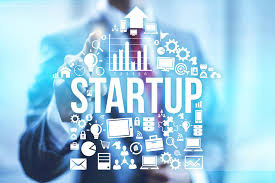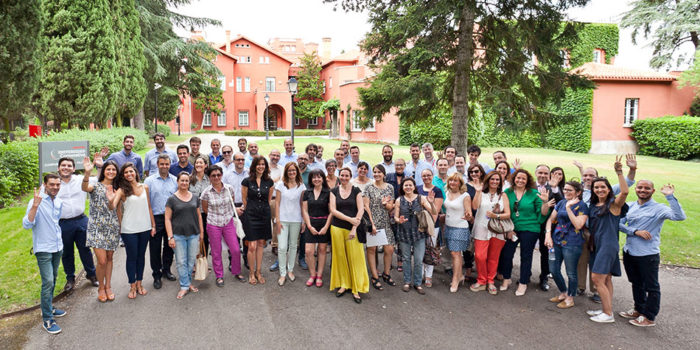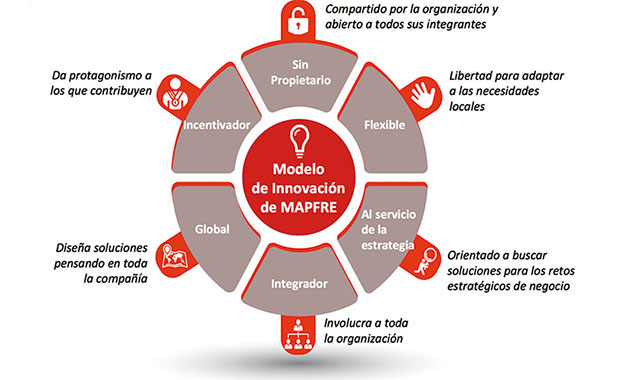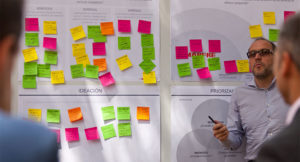JOSEP CELAYA
Innovation Corporate Director at MAPFRE
“Ongoing innovation is the only way to remain competitive, because no advantage is sustainable in the long term”, said Albert Einstein.
Why innovation is invading major companies to such a great extent?
Technological change.
Sector overlaps.Emergence of new players who are more agile.Changes in client priorities and necessities.Acceleration of demands with regard to time to market
Insurance solutions on the market. The role of Start-Ups
We could analyze two different stages in the emergence of new models for Start-Ups in recent years. The first wave of Start-Ups began about 5 years ago with the so-called FINTECH, and which essentially involved a revolution in payment methods, alternative banking, cryptocurrency, and banking platforms. At this stage, as a point of reference, the world of data took on special significance and what is most sought after is immediacy. Following this, a second wave of Start-Ups cam be identified, with a noticeably technological slant and which is searching for applicability in the Insurance Industry, INSURTECHs.
The difference between the two lies in that, while Fintech is a more disruptive wave, with examples like peer to peer lending (loans between private individuals), Insurtech is a more collaborative wave, contributing cooperative models and a greater symbiosis with the insurance industry, with examples like initiatives focusing on risk analysis, visualization and exposure of environmental risks, parametric forecasts, etc.

The result of these developments is that Insurtech’s value proposition is an improvement with regard to Fintech because it is essentially collaborative rather than competitive.
Insurtechs are a growing phenomenon. Insurtech presupposes a new ecosystem made up of insurance companies, technological giants and disruptive Start-Ups which is transforming the insurance industry.
MAPFRE recently decided to invest, for example, in the Alma Mundi Innvierte Fund, FCRE, specializing in investing in Start-Ups in Spain, Latin America and the United States, some of which are developing technological projects relating to the insurance industry.
This investment represents MAPFRE’s great commitment to Start-Ups. Projects being developed by emerging companies in which this fund is investing include those focusing on remote medical consultation, the Internet of things in Health and Home and behavior forecasting.
Alma Mundi for example is actively promoting Spain 3.0, supporting Spanish and foreign Start-Ups that locate their engineering resources and value-added processes in Spain.
Challenges to application in major company´s, MAPFRE´s strategy

Experts in the sector appear to agree that the key to innovation in our market resides in the capacity to integrate innovation into the insurance company’s business model. This capacity may be acquired, for example, by applying artificial intelligence, blockchain and big data, with the aim of achieving more efficient processes, and to create new payment systems and models based on the sharing economy. The challenge in this field is ongoing. If the incumbents, as traditional companies are called, do not adapt to their clients’ life cycle, offer them a unique product and a differentiated experience, others will do so in their place.
If we consider the contrast between the Start-Ups’ ecosystem compared with that of the major organizations, we find that the great challenge is how to make them compatible. The essence of the former is based on flexibility and on taking decisions quickly to resolve their clients’ requirements. However, a major corporation is generally based on stricter procedures, solvency principles, strict policies, security, and stricter procedures and mechanisms for taking decisions.
In this regard, the MAPFRE Corporate Innovation Division focuses on two main actions:
- External Action: based on promoting the convergence of both ecosystems via the strategy of building bridges and providing links for learning, synergies and win-win business.
- Internal Action: undertaken within the MAPFRE organization and which could be called a global Intraundertaking, promoting the creative potential of the organization’s internal talent, creating multidisciplinary work teams made up of so-called Innoagents, creating suitable spaces for generating ideas, and above all preparing the members of the organization with a common methodology (Design Thinking y Lean Start-Up) and equipping them with collaborative tools for sharing knowledge in all the geographical areas where there are MAPFRE companies.
MAPFRE is aware of this situation which is why for some years now it has been developing an Innovation model focusing on the development of value propositions directed toward the client. The MAPFRE Innovation Community is a structure in the form of a network whose threads are interconnected bidirectionally, and which acts by identifying the strategic business challenges which need to be addressed from the innovation standpoint, offering methodological support and tools for the development of projects in this field.

In this model a key role is played by the “innoagent”, a term which designates those who act as ambassadors for Innovation in MAPFRE from the different countries and Business Units, in other words, transmitters of the innovation culture.
Their task is effectively that of identifying innovation ideas and projects within the organization, taking an active part in them, and supporting all the departments on a technical and sales level, always with the aim of achieving the strategic plan’s objectives.
An essential role is also played in the MAPFRE Innovation Community by the Innovation and Development Offices (OID) who work at a local level as catalysts for innovation, managing projects which have arisen in the different countries and Business Units. MAPFRE currently has 19 OIDs with a network of over 300 Innoagents at global level.
There are numerous trends linked with innovation and technology which have radically changed the way in which the insurance industry used to work. The risks for which we are prepared today are not necessarily those we will face tomorrow and this presents a challenge for which we need to be ready.
Furthermore, MAPFRE RE has recently become a member of the Blockchain Insurance Industry Initiative, better known as B3i, an initiative launched in October 2016 to explore the use of distributed ledger technology and to develop common standards for the insurance industry. The B3i seeks to promote Blockchain with the objective of penetrating the insurance industry on a global scale with the use of Distributed Ledger Technology (DLT). The companies belonging to this consortium will share their experiences with the tool, contributing in this way to the development of a feasible business platform for insurance and reinsurance in the second half of 2018.
In the following video, Josep Celaya, MAPFRE Corporate Innovation Manager, explains what Blockchain is and along what lines MAPFRE is working in this new technological macro trend:
But in MAPFRE the innovation model is much more than technology, it is how we understand processes, finances, people management, the client experience, etc. to be prepared for the changes which the future implies. We are working on this adaptation with strategic initiatives which will give us competitive advantages which respond to the real needs of our clients.
As of July 2017 there were 84 active Innovation Projects in MAPFRE. These projects are classified according to their potential impact on the organization, and may be Local, Global or Corporate.
Innovation in MAPFRE is considered to be one of the main levers for promoting organic growth and the company’s progress in its strategic objective. Innovation in MAPFRE means developing differential value propositions aimed at strategic client segments with a transversal vision for meeting the different business challenges.

When we speak about innovation, we are not talking about innovation in a strict product/service sense, but innovation in a much wider sense which addresses all entrepreneurial concepts: strategy, processes, services… in other words, the concept of innovation goes way beyond “developing new products” or “technology”.
Soren Kaplan, in his book “The invisible advantage. How to create a culture of innovation” gives a series of recommendations for creating an innovation culture throughout the whole organization. It is based on three current realities:
- Competitive advantages are temporary. For products, services and even business models not to fall into obsolescence they need to be continually invented and reinvented.
- Culture is the only sustainable competitive advantage. It is the invisible ingredient which mobilizes the commitment of the professionals, innovation, reinvention and the growth of the organization.
- Each organization should be a leader of its innovation culture in a unique way and should adapt to the personality of the same. What is successful in one will not necessarily triumph in another.
Kaplan confirms that to have an innovation culture it is essential to promote and support a work environment in which all the professionals understand their role with regard to “changing the game” for the better, independently of their role or function within the organization.
This is why everyone who is a part of our organization is represented in one way or another in the MAPFRE Innovation Community. To innovate is to use the knowledge we have to generate new ideas, that is why it is not an isolated quality destined to the few. Josep Celaya, the Corporate Innovation Manager for the company puts it like this: “The innovation teams are just the catalyst. The responsibility for innovation lies with all of us wishing to contribute to MAPFRE continuing to be a leader in the markets where we operate.”





